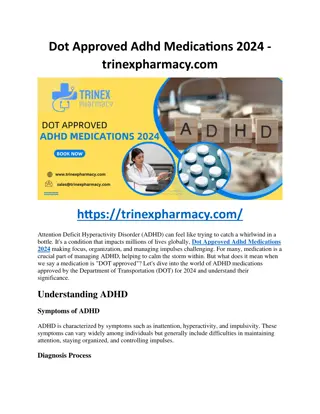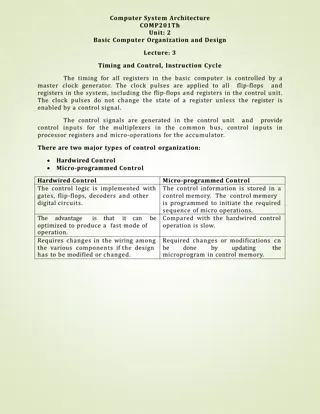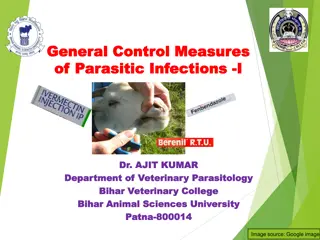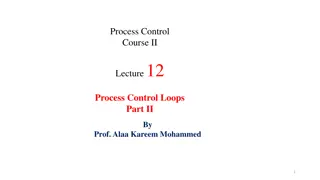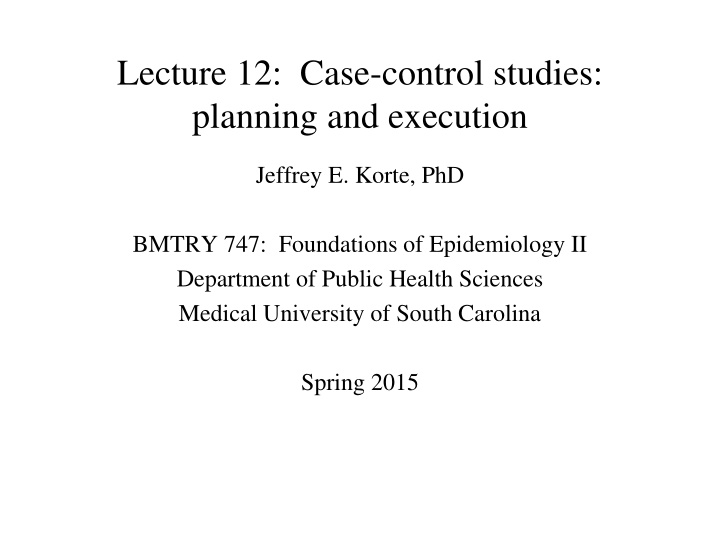
Planning and Execution of Case-Control Studies in Epidemiology
Explore the planning and execution of case-control studies in epidemiology, including the identification of cases and controls, comparison of background characteristics, and analysis of risk factor exposure. Learn about the different types of cases, common pitfalls to avoid, and the impact of case-control studies on hypothesis exploration.
Download Presentation

Please find below an Image/Link to download the presentation.
The content on the website is provided AS IS for your information and personal use only. It may not be sold, licensed, or shared on other websites without obtaining consent from the author. If you encounter any issues during the download, it is possible that the publisher has removed the file from their server.
You are allowed to download the files provided on this website for personal or commercial use, subject to the condition that they are used lawfully. All files are the property of their respective owners.
The content on the website is provided AS IS for your information and personal use only. It may not be sold, licensed, or shared on other websites without obtaining consent from the author.
E N D
Presentation Transcript
Lecture 12: Case-control studies: planning and execution Jeffrey E. Korte, PhD BMTRY 747: Foundations of Epidemiology II Department of Public Health Sciences Medical University of South Carolina Spring 2015
Case-control study People with a given disease identified Cases People without the disease identified Controls Analysis: compare background characteristics, and/or risk factor exposure, between cases and controls
Case-control study Sometimes called: Case-comparison study Case-referent study Retrospective study
Case-control study Cases could be: Incident cases identified prospectively through time (through the study period) This is typical Prevalent cases (people who were diagnosed with the disease in the past) Sometimes called retrospective case-control study
Case-control study Definitely the most common study design in analytic epidemiology Relatively quick Relatively inexpensive Might be the only practical option to identify risk factors for a rare disease
Case-control study: pitfalls Potential sources of bias and error include: Accurate information on risk factor may not be available (from participant s memory, or from records) Accurate information on potentially important confounders may not be available Cases may search for a cause for their disease, therefore be more likely to report exposure than controls (recall bias)
Case-control study: pitfalls Potential sources of bias and error include: May be unable to determine direction (or presence) of causality (exposure disease or disease exposure) Identifying and assembling a representative case group may be difficult Ditto for controls Participation rates may be low
Case-control study: impact Sometimes thought of as a study design to provide leads, but not to definitively address a hypothesis Conduct cohort study (or RCT, if appropriate) to try to achieve that goal Nevertheless sometimes case-control studies have single-handedly led to major changes in clinical practice
Case-control study (leading to clinical change) Example 1: HPV Case-control studies of cervical cancer were sufficient to: Inspire development of clinical HPV tests Change screening strategies Inspire development of vaccines
Case-control study (leading to clinical change) Example 2: diethylstilbestrol (DES) DES was a frequently prescribed therapy for prevention of miscarriage Pulled off market after case-control studies demonstrated strong link with clear-cell carcinoma of the vagina (and other genital abnormalities) in daughters of DES patients
Case-control study (leading to clinical change) First DES case-control study:
Case-control study (leading to clinical change) 1981 DES review by Herbst: 400 cases had been identified (clear cell adenocarcinoma in young women) 61% were exposed to DES or related drugs 10% exposed to unidentified meds for high risk pregnancy 25% had maternal hormone usage 2.5% exposed to non-DES type hormone Nonmalignant changes of genital tract including
Case-control study (leading to clinical change) 1981 DES review by Herbst: Nonmalignant changes of genital tract including: Vaginal adenosis Cervical ectropion/eversion Squamous metaplasia Metaplastic epithelium Transverse vaginal/cervical ridges
Case-control study: bias Likelihood and magnitude of bias varies from study to study Example: study of coronary heart disease Association with psychological stress difficult to interpret Stress coronary heart disease? Coronary heart disease stress? Recall bias? Association with blood group O unambiguous Only problem would be if survivorship differed by blood group
Case-control study: suitability Good for rare diseases Good for diseases which lead people to seek medical care Facilitates an unbiased identification of cases Good for diseases with relatively quick onset (short time between appearance of symptoms and diagnosis/interview) Easier to identify risk factors occurring before disease process began
Case-control study: sampling Incidence-density sampling Incident cases are sampled as they occur Controls are sampled over the same time period This may be a matched or unmatched study Controls may develop the disease and become cases during study period This is the sampling strategy for most case- control studies
Case-control study: sampling Cumulative incidence sampling Cases arising during study period are sampled Controls are sampled from people who are still disease-free at the end of the study period This approach is commonly used in: Studies of reproductive outcomes Studies of short-term epidemics
Case-control study: estimates Consider what you want to estimate before planning the study Proportion of cases and controls exposed Intensity and length of exposure Changes in exposure status over time Exposures at critical time periods e.g. first month of gestation
Case-control study: estimates Usual measure of association: odds ratio Rare disease: OR, risk ratio, and rate ratio are similar under incidence-density or cumulative incidence sampling Any disease: if incidence and proportion of population exposed both stay stable during study period, then OR is good estimate of rate ratio under incidence-density sampling
Selection of cases Newly diagnosed cases preferable Easier to remember exposures Easier to distinguish exposures occurring before and after disease onset Prevalent cases not preferable Overrepresentation of cases of long duration Observed exposure-disease relationship may actually be the relationship between exposure and duration of disease
Selection of cases: incidence Time of diagnosis may approximate time of onset for some diseases (e.g. fracture) For other diseases (e.g. colon cancer): important to make sure exposure preceded onset of symptoms Symptoms may influence some exposures, e.g. diet, exercise, weight (may be weight loss from subclinical disease)
Selection of cases: incidence Disease with slow onset: how to define incident case? May be appropriate to determine date of symptom onset in questionnaire, and exclude cases whose symptoms began long before study period or diagnosis (e.g. one year)
Selection of cases: diagnosis Diagnostic criteria should be established for the study e.g. cancer: pathologist confirmation Conditions with no definitive criterion: can establish scale of certainty e.g. confirmed , probable , possible In analysis: assess whether risk factors are the same for all categories of cases (if so, can combine cases)
Selection of cases: sampling Ideal: Recruit all incident cases from a defined population over a defined time period This can be possible with disease registries (e.g. SEER), and in studies of reproductive outcomes More common: Recruit all incident cases seen at specified hospitals over a defined time period
Selection of cases: sampling Recruiting cases from hospitals If disease usually leads to a hospital visit, then this strategy should provide an acceptably representative case group If disease does not always lead to a hospital visit, then you should also try to recruit cases seeking care from office-based physicians Some physicians might not allow access to their patients for your research study
Selection of cases: sampling More uncommon sources of cases: Prepaid health plans Schools Places of employment Military service Patient service organizations
Selection of cases More than one case group might be compared to a single control group Different diseases with similar suspected risk factors (e.g. breast cancer, endometrial cancer, ovarian cancer) Disease subtypes with suspected etiologic differences (e.g. estrogen-dependent versus estrogen-independent breast cancer)
Selection of controls: concept Schlesselman (1982): The control series is intended to provide an estimate of the exposure rate that would be expected to occur in the cases if there were no association between the study disease and exposure. Miettinen (1985): The controls should be selected in an unbiased manner from those individuals who would have been included in the case series, had they developed the disease under study.
Selection of controls: concept Wacholder (1992): The most difficult issue is the correct identification of the appropriate study base Study base: the set of people among whom those developing the disease will become cases in the study
Selection of controls: practice Random sample of the population from which the cases came Or: People seeking medical care at the same institution as the cases For diseases believed to be unrelated to the disease under study Or who did not have the outcome of interest (e.g. pregnancy outcome) Or were found to be disease-free, i.e. in a screening program Or: Neighbors of the cases
Selection of controls: practice Less common sources of controls: Friends Schoolmates Siblings Fellow workers
Population-based controls Random or probability sample of source population Usually geographically defined Random-digit dialing Becoming MUCH more complicated Almost everyone has a telephone, but: Multiple numbers per person (residential, cell, work) Non-local area codes (cell, Vonage, etc.) Caller ID and call screening
Population-based controls Random-digit dialing Only 20% of phone numbers are assigned to households/people Two-stage sampling method (Waksberg, 1978) has often been used Assemble complete list of 8-digit primary sampling units (PSUs) (e.g. 843-856-50xx) If first random number from a given PSU is not a household, reject that PSU
Population-based controls Random-digit dialing Other issues: Necessity of keeping careful records of each call Determining how many household members use that telephone Asking how many telephone numbers a household has Deciding which household member to interview Often depends on study question (e.g. hormone replacement therapy) Deciding whether interview should be in person or over the phone Deciding what to do when nobody answers after repeated calls Deciding what to do about answering machines, call forwarding, etc.
Population-based controls Some countries (or regions) have relatively accurate population registries: controls can be selected at random from registry Several European countries Shanghai Resident Registry National census in Costa Rica (in US, census results not available on individual level)
Population-based controls (convenience samples) Some case groups are not from populations defined by geographic boundaries People in an HMO; workers at a particular plant; births at certain hospitals; screening population In these cases, the most appropriate control groups may not be population-based Other people in the HMO; other workers at the plant; other births at the hospital; screened healthy patients
Hospital-based controls Fairly frequent control sampling strategy Disadvantage: controls are sick But may equalize some selection factors relative to the cases Selection factors differ by hospital service Controls therefore are usually chosen from other patients in the same service as the cases e.g. breast cancer cases; controls recruited from general surgery service
Hospital-based controls: diagnosis Include controls with a variety of conditions Examine distribution of diagnoses after control group is assembled Bias may result if large proportion of controls have a condition related to studied disease, or a condition with the same risk factors e.g. lung cancer controls in a study of smoking and bladder cancer (underestimate the OR) e.g. study of OC and breast disease; 25% of controls had gallbladder disease (related to OC use)
Hospital-based controls May be appropriate to exclude controls who have had their diseases for a long time Exposure to risk factors of interest may have changed as the result of their condition Many different diseases have an impact on diet, exercise, weight, medication use, etc.
Hospital-based controls May be the only viable option for some research questions e.g. HPV in laryngeal cancer: only feasible control group is people with benign laryngeal lesions that are being excised anyway. Cannot ethically remove laryngeal tissue from healthy controls (reduce/lose ability to speak) Sometimes autopsy controls may be the only option (e.g. lung tissue comparisons)
Neighborhood controls Useful when source population cannot be defined Controls are presumably healthy (as opposed to hospital controls) Major assumption: if the neighbor got the disease of interest, (s)he would go to the same hospital as the case (this may be a bad assumption)
Neighborhood controls: sampling Matched on neighborhood Usually also matched on age and gender Rough matching for sociodemographic factors (income, wealth, perhaps race), and some environmental exposures This may result in over-matching if these are study variables
Neighborhood controls: sampling Recruiter must canvas the neighborhood under a well-defined and strict set of rules until an appropriate control is found e.g. first house to the right, then first house to the left, then second house to the right, etc. Must not skip houses just because nobody is home (multiple call-backs may be required therefore this is more expensive than random- digit dialing)
Friend controls Case is asked for the name of a friend who does not have the disease of interest May be intentionally matched on age, gender, etc. Will be matched on numerous social characteristics as well
Friend controls: pitfalls Over-matching is relatively likely Cases and friend controls may be more similar on exposures of interest than cases and unmatched population controls e.g. coffee drinking Odds ratio will not be biased in an appropriate matched analysis (only discordant pairs are informative), but study will be very inefficient
Friend controls: pitfalls If the exposure of interest is a determinant of friendship, then selection into the control group is partially dependent on the exposure Selection bias e.g. occupational exposures: people who work together sometimes become friends This bias will not be corrected by using a matched analysis
Friend controls: pitfalls Some cases have more friends than others Some cases may not want to give their friend s name to the investigator Some (most) cases may not randomly select a friend Friend nominated may like to talk, or is most sociable, or is most interested in research; bias will result if this is related to the exposure of interest
Control selection: final word Theoretically best: random sample of population base Strategies for population-based control sampling may be difficult to implement The best control sampling strategy may need to be tailored to your study Location, study population Study question of interest Most valid comparison group that is feasible






